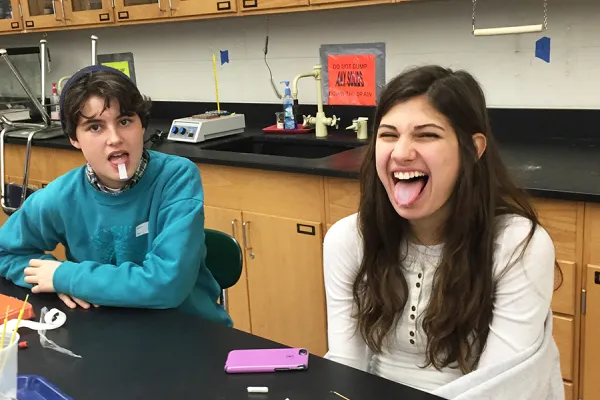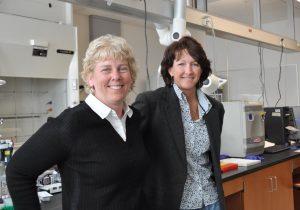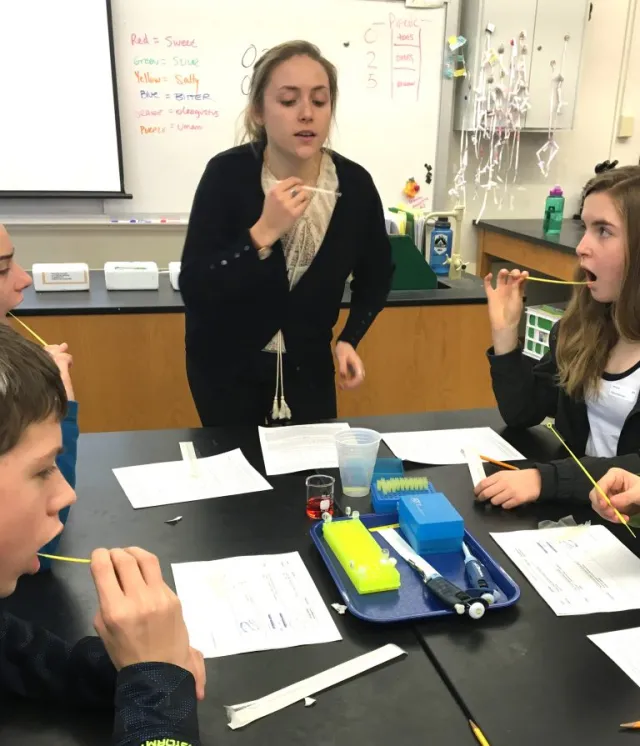Creating ‘Aha’ Moments: Smithies Teach Science to High School Students
Campus Life

Published May 5, 2016
Research has shown that group work and active learning are pedagogical strategies that have a positive impact on students’ attitudes toward science. That is exactly what eight Smith students experienced while teaching 9th-grade biology classes at Northampton High School this year.
The Smith students were part of this year’s Interterm High School Science Teaching Internships, a program developed by Christine White-Ziegler, professor of biological sciences, and Lou Ann Bierwert, technical director of Smith’s Center for Molecular Biology. The program was supported with grant funding from the Howard Hughes Medical Institute (HHMI) through the Precollege and Undergraduate Science Education Program.

Christine White-Ziegler (left), professor of biological sciences, and Lou Ann Bierwert, technical director of Smith’s Center for Molecular Biology.
The course was built around a three-day lab experiment that tests a person’s ability to taste phenylthiocarbamide (PTC), a chemical substance that is horribly bitter to some and completely tasteless to others. Students collect cheek cells and analyze their own DNA to discover which of their genes either allow or prevent them from tasting PTC.
High school teachers report such hands-on activity helps students learn difficult concepts, while having fun learning about themselves.
“My students were invested in the learning experience because they were working with their own DNA. How cool is that?” said Kate Dollard, who has taught at Northampton High School for more than 10 years.
Smithies also learned valuable lessons as teaching interns.
“I found a deeper appreciation for biology and why I find it fun,” said Haley Barravecchia ’18. “This program inspired me to follow up with other teaching and tutoring opportunities.”
Cadence Miskimin ’17 says she enjoyed seeing “the ‘aha moment’ on the faces of students” as they mastered scientific concepts through practice and repetition.
“I found that helping someone else achieve this moment of understanding was even more rewarding than achieving it myself,” Miskimin added.
Other Smith teaching interns this year were Jamie Chan ’19, Analy Duong ’17, Bethaney Gulla-Devaney ’18, Renee Klann ’19, Siphokazi Kargbo ’18 and Jocelyn Yax ’18.
The Smith students met for 10 hours of training in the fall, followed by two days of practice in January before their three-day classroom stints. Training included a review of state guidelines for what high school students are expected to learn, as well as inquiry-based teaching and classroom management techniques.
High school students offered rave reviews in their thank-you notes to Smith teaching interns.
“I had so much fun during the activity and being able to do so much of the lab on our own,” one 9th-grader wrote.
“The opportunity to work with such advanced equipment was so enjoyable and I thank you for it. You have contributed significantly to my learning experience and sparked an interest in a new field of science for me,” wrote another.
For Smith alumna Jenna Zukswert ’13—who recently completed a master’s degree in forestry—the most valuable part of the internship was the experience of leading a classroom.
“Through this internship, I discovered that I love teaching and am passionate about science outreach and education,” said Zukswert. “I have since volunteered in other science education programs and am applying for jobs in science communication.”
Since the internships began nine years ago, Smith students have taught lessons in genetics and molecular biology to more than 1,800 local high school students. With HHMI funding ending this spring, Smith’s Center for Molecular Biology is working with high school teachers to continue use of the curriculum developed for the science teaching internships.

Haley Barravecchia ’18, shows Northampton High School students how to collect cheek cell samples so they can analyze their DNA.
Northampton High School students try paper soaked in PTC, a substance that tastes bitter to some but is tasteless to others.